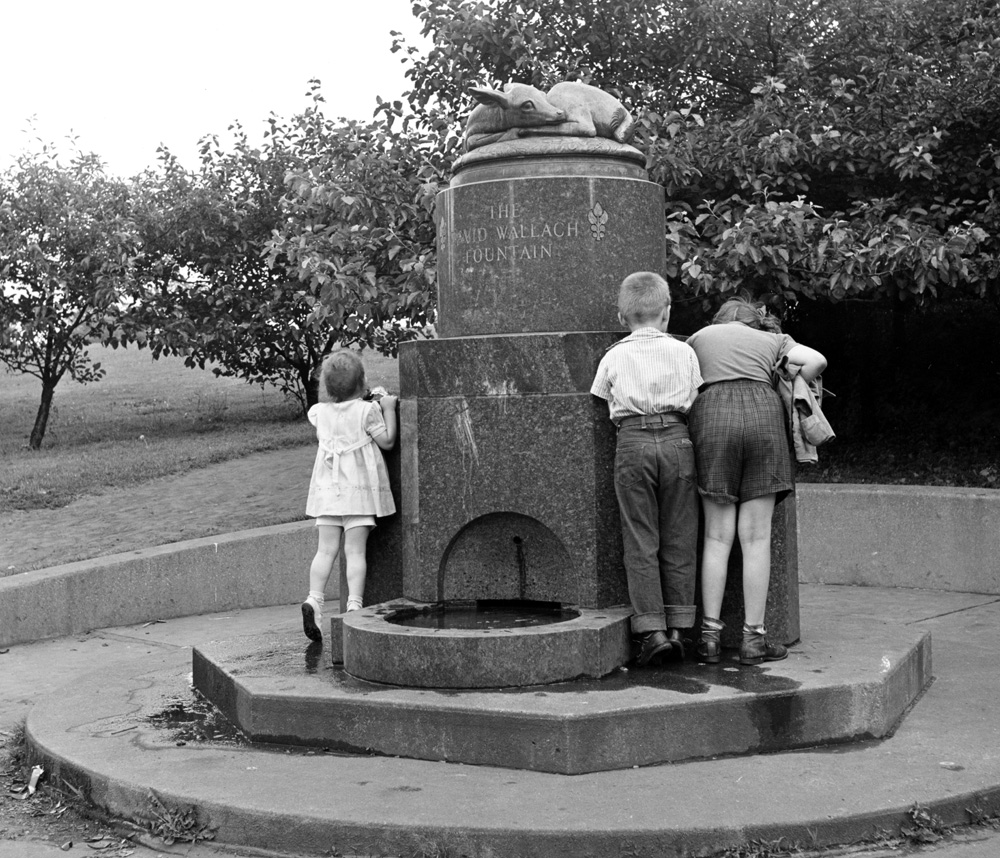 |
| The David Wallach Fountain (taken 2018) |
I love walking through the 55th Street tunnel to the Point and seeing the David Wallach Fountain. But who was David Wallach? Is he a good person to be guarding the park?
I went on the search and found out that David Wallach was born in Prussia in 1832, immigrated to the United States at 18, and moved to Rockford to run a store with his brother. By the 1860s, Rockford apparently seemed a bit small and slow. He moved on to the ever-expanding Chicago nearby. He had done well enough for himself that he became a partner with Cahn, Wampole & Co., wholesale clothing manufacturers based in Chicago. He accumulated a small fortune.
 |
Sketch of David Wallach (Chicago Chronicle,
November 5, 1895) |
After his retirement from the firm in 1891, he was apparently a bit bored and started up a photographic supply business. That apparently is why the Park District identifies that as his call to fame, but he died just two years after starting Sweet, Wallach, & Co. and it doesn't seem to have survived his death. The only trace I found was an 1892 catalog in the National Museum of American History archives.
At his death in 1894, the Cook County Death Index called him a “capitalist.” He called himself a “wholesale clothing merchant,” but I’d label him “philanthropist.” After his death, the Chicago Chronicle said that, despite Wallach’s wish for quiet giving, the board of every charity in the city knew him and knew that, if they reached out, it was never in vain. It's not surprising. He was a member of Chicago Sinai Congregation, whose influential rabbi, Emil G. Hirsch, inspired his congregation to address the social ills of the day. Hirsch was a professor at the University of Chicago. Another member of the congregation was Julius Rosenwald.
Wallach’s will made some of his philanthropy visible. Among the bequests were ones to Michael Reese Hospital, the Institute for Crippled and Destitute Children, and homes for the elderly. The biggest gift, about 10% of his estate, went to the Chicago Orphan Asylum. The need was great because smallpox and cholera epidemics orphaned children throughout the 19th century. He didn’t just give cash. He also gave his time, bringing the children treats because he wanted them to have some joy.
After Wallach’s death, his close friend, Dr. Edmund J. Doering, wanted the children to remember “their staunchest supporter” so he endowed an annual “David Wallach Day” with puppet shows, magicians, ice cream, and cake for the 200 children. But the annual day faded away in a few years, which often happens to memorials that rely on institutional memory.
There was one donation in Wallach’s will that the Tribune made a fuss over. Upon his wife’s death, $5,000 ($159,000 in 2021 dollars) would finance a fountain for “men and beasts” at a location south of 22nd Street, north of 33rd Street, and east of Michigan Avenue. Wallach had lived at 3332 S. Vernon. It was his gift to the working horses in his neighborhood and one he was willing to put his name on.
But no fountain appeared.
In 1914, his sister in New York wrote the mayor of Chicago asking why there wasn’t a fountain. The city scrambled to unearth the will. Alderman George F. Harding, Jr. (yes, the Harding who collected medieval armor) was delighted. Harding had gone to school with Wallach’s son, and he thought the intersection at 35th Street, Vincennes, and Cottage Grove in his ward would be perfect for a dramatic fountain.
And yet, no fountain appeared.
In 1937, Wallach’s heirs asked again. Lawsuits ensued. Once the dust settled, the heirs and the Park District formed a committee to find a location and a design. Wallach’s heirs were living in Hyde Park, in the Parkshore on 55th Street near South Shore Drive. They had watched Alfred Caldwell landscaping Promontory Point next door and thought the new park would be an ideal setting. The American Legion and Veterans of Foreign Wars didn’t agree. They sued to move it to 47th Street. The judge tossed the case, saying the will specified 55th Street, which, of course, it hadn’t. Whatever their plans were, by the time the VFW and the Legion tried to get their hands on the will, it was too late.
The Park District and the heirs held a design competition, which local artists, Frederick Hibbard and Elizabeth Haseltine Hibbard, won. Elizabeth Haseltine designed my favorite part, the fawn. Haseltine taught at the University of Chicago and assisted Lorado Taft. She was acclaimed for her Baby Pegasus sculpture, which she exhibited several times at the Art Institute. I suspect Baby Pegasus would have delighted Wallach, but Haseltine wanted something naturalistic to match Caldwell’s landscape. I also suspect the artists wanted a rounded shape atop the streamlined Art Deco base.
The base, designed by Frederick Hibbard, is Dakota Mahogany granite. It’s polished to protect it from the weather even though it’s very hard rock billions of years old. They clearly wanted a monument that would last. By 1939, working horses were rare. There were bridle paths nearby, but the committee argued that horses couldn’t access the Point. They abandoned trying to fit a horse trough into the design. I have a theory that the horse trough interrupted their Art Deco streamlining. Instead, the committee accommodated “men and beasts” with a low basin for dogs and three drinking fountains sized for children.
Certainly the Tribune huffed about it. They ran a headline that you could lead a horse to this fountain, but there was nowhere for a horse to drink. That's not entirely true. I have seen a horse drink from it, but it is better for birds, dogs, and children. I think David Wallach would have liked helping the children.
For more about Haseltine and the history of the fawn: Hyde Park Stories: Elizabeth Haseltine and the Fawn (trishmorse.blogspot.com)








